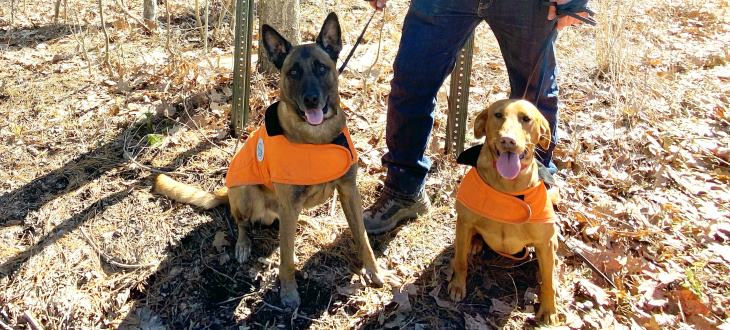The State We're In
A nose for conservation
Dia, Fagen and Fly are high-energy dogs who love to run through woods and fields for hours, their noses to the ground.
While it’s all play to them, their outings have a serious purpose: sniffing out invasive plants and insects, and helping scientists learn about the locations and movements of New Jersey’s endangered and threatened animals.
Dia, Fagen and Fly are “conservation dogs,” trained to use their sensitive noses to detect specific animals and plants. They can find target species far more efficiently than people, who rely on eyesight alone.
Dia, a Labrador retriever, and Fagen, a Belgian malinois, work with handler Joshua Beebe of the nonprofit New York-New Jersey Trail Conference to sniff out invasive plants and insects. Fly, a cattle dog mix, helps biologist Gretchen Fowles of the state’s Endangered and Nongame Species Program track rare animals for her research.
In addition, the nonprofit Clean Ocean Action has brought in dogs from Maine-based Environmental Canine Services to track down sources of pathogen pollution, like raw sewage, in the Navesink River in Monmouth County.
For Dia and Fagen, a typical day on the job might mean sniffing through a vineyard or farm to detect invasive spotted lanternflies – a serious threat to agriculture – or trotting through parks and nature preserves in search of invasive plants like Scotch broom.
“With invasive species, early detection is key to eradicating them,” notes Beebe. “We’ve got to get in there while populations are still relatively small.” With their powerful sniffers, Dia and Fagen can find tiny seedlings just sprouting from the ground, or plants hidden out of sight beneath heavy foliage.
For Fly, a day at work might mean running through a Highlands forest searching for the scat of bobcats, an endangered species in New Jersey. By testing the DNA of the scat, scientists are learning about the movements of bobcats throughout the state. This knowledge helps protect bobcat habitat. Fly is also being trained to track Eastern box turtles, a species of special concern in New Jersey.
Dia, Fagen and Fly got their jobs thanks to the efforts of Working Dogs for Conservation, a Montana-based nonprofit that has pioneered the use of dogs’ extraordinary sense of smell to protect wildlife and wild places. And it’s especially great that many of the dogs they train are adopted from shelters.
According to the Working Dogs for Conservation website, dogs are suited to sniffing out plants and animals because their sense of smell is 10,000 to 100,000 times stronger than that of humans. Dogs have at least 220 million scent receptors in their noses, as opposed to only about 5 million for humans. In addition, dogs can smell continuously – not just on inhale.
What kind of temperament does it take to be a conservation dog? According to Josh and Gretchen, the ideal candidate is energetic, driven, confident, physically fit, and not fearful of rough terrain or tight places. Conservation dogs must also be highly motivated to work for their reward – usually, a vigorous session of tug and fetch with their handlers after a successful search.
“They love it,” said Josh. “It’s like the dream job for these dogs – running around in the woods, looking for stuff. It really is their favorite thing. It’s a game for them.”
He noted that the extreme energy and drive that make conservation dogs great at outdoor tracking can make them less desirable as household pets: “A lot of these dogs are those that have trouble getting adopted.” Without the conservation dog program, some might not have found homes.
Gretchen describes Fly – who came from a shelter in Wyoming – as a “hardworking and focused” dog who loves playing with her ball. “That obsession with playing with a ball is what keeps her going – playing with her special toy is her reward for finding a particular target,” said Gretchen. “When she finds a target, she is trained to lie down next to it (not touch it) to indicate that she has found something.”
Fly isn’t the first conservation dog used by the Endangered and Nongame Species Program. Fly replaces Bear, a bobcat tracking dog who passed away two years ago. Bear was also handled by Gretchen.
How about a big woof and a tail thump to the conservation dogs and their handlers for helping New Jersey’s environment, agriculture and scientific research?
To learn more about the New York-New Jersey Trail Conference’s conservation dog program, go to https://www.nynjtc.org/content/conservation-dog-program.
To learn about the Endangered and Nongame Species Program’s use of dogs to detect bobcats, go to https://www.state.nj.us/dep/fgw/ensp/pdf/end-thrtened/bobcat.pdf.
To learn about Working Dogs for Conservation, visit the group’s website at https://wd4c.org/.
And to learn more about preserving New Jersey’s land and natural resources, visit the New Jersey Conservation Foundation website at www.njconservation.org or contact me at info@njconservation.org.
About the Authors
Alison Mitchell
Co-Executive Director
John S. Watson, Jr.
Co-Executive Director
Tom Gilbert
Co-Executive Director, 2022-2023
Michele S. Byers
Executive Director, 1999-2021
View their full bios here.
Filter
Get The Latest News
From The Garden State
In the
News

